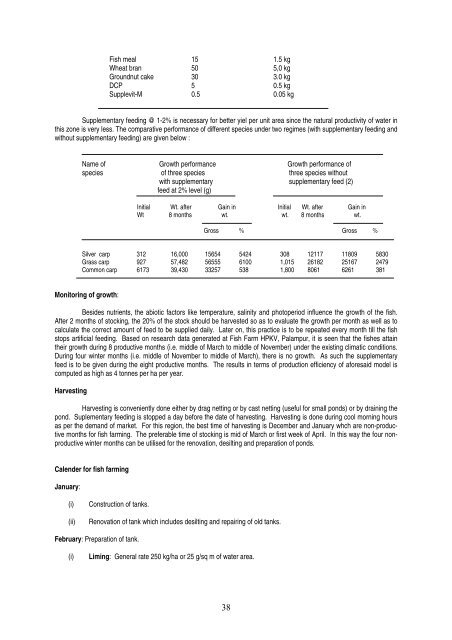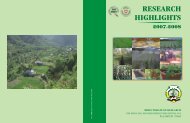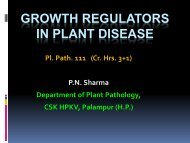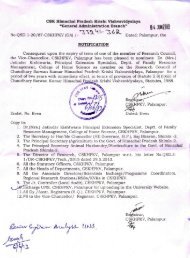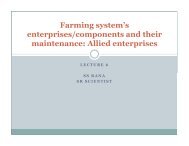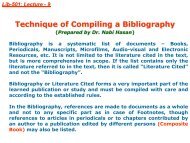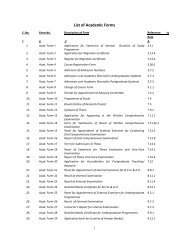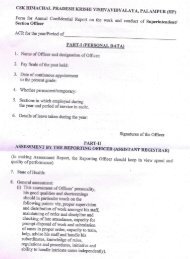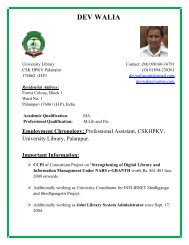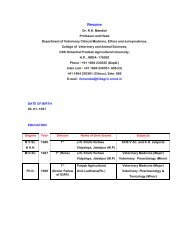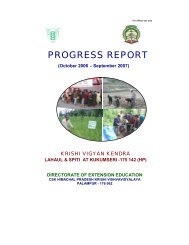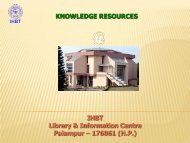animal production - CSK Himachal Pradesh Agricultural University ...
animal production - CSK Himachal Pradesh Agricultural University ...
animal production - CSK Himachal Pradesh Agricultural University ...
Create successful ePaper yourself
Turn your PDF publications into a flip-book with our unique Google optimized e-Paper software.
Fish meal 15 1.5 kg<br />
Wheat bran 50 5,0 kg<br />
Groundnut cake 30 3.0 kg<br />
DCP 5 0.5 kg<br />
Supplevit-M 0.5 0.05 kg<br />
Supplementary feeding @ 1-2% is necessary for better yiel per unit area since the natural productivity of water in<br />
this zone is very less. The comparative performance of different species under two regimes (with supplementary feeding and<br />
without supplementary feeding) are given below :<br />
Name of Growth performance Growth performance of<br />
species of three species three species without<br />
with supplementary supplementary feed (2)<br />
feed at 2% level (g)<br />
Initial Wt. after Gain in Initial Wt. after Gain in<br />
Wt 8 months wt. wt. 8 months wt.<br />
Gross % Gross %<br />
Silver carp 312 16,000 15654 5424 308 12117 11809 5830<br />
Grass carp 927 57,482 56555 6100 1,015 26182 25167 2479<br />
Common carp 6173 39,430 33257 538 1,800 8061 6261 381<br />
Monitoring of growth:<br />
Besides nutrients, the abiotic factors like temperature, salinity and photoperiod influence the growth of the fish.<br />
After 2 months of stocking, the 20% of the stock should be harvested so as to evaluate the growth per month as well as to<br />
calculate the correct amount of feed to be supplied daily. Later on, this practice is to be repeated every month till the fish<br />
stops artificial feeding. Based on research data generated at Fish Farm HPKV, Palampur, it is seen that the fishes attain<br />
their growth during 8 productive months (i.e. middle of March to middle of November) under the existing climatic conditions.<br />
During four winter months (i.e. middle of November to middle of March), there is no growth. As such the supplementary<br />
feed is to be given during the eight productive months. The results in terms of <strong>production</strong> efficiency of aforesaid model is<br />
computed as high as 4 tonnes per ha per year.<br />
Harvesting<br />
Harvesting is conveniently done either by drag netting or by cast netting (useful for small ponds) or by draining the<br />
pond. Suplementary feeding is stopped a day before the date of harvesting. Harvesting is done during cool morning hours<br />
as per the demand of market. For this region, the best time of harvesting is December and January whch are non-productive<br />
months for fish farming. The preferable time of stocking is mid of March or first week of April. In this way the four nonproductive<br />
winter months can be utilised for the renovation, desilting and preparation of ponds.<br />
Calender for fish farming<br />
January:<br />
(i) Construction of tanks.<br />
(ii) Renovation of tank which includes desilting and repairing of old tanks.<br />
February: Preparation of tank.<br />
(i) Liming: General rate 250 kg/ha or 25 g/sq m of water area.<br />
38


